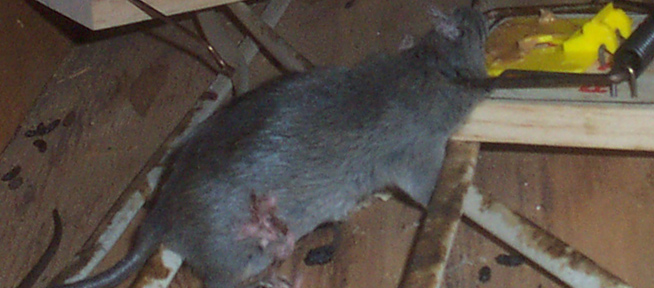Your garage is a great place to set up home for a small animal like a rat, mostly because you don't go in there that often, especially when the weather gets cold. There's so much stuff stashed away in there, you'd never see a mouse or a rat hiding in among the rubble and boxes of stuff. It's warm, sheltered, and a great place to rest for a while, or to raise a small furry family.

Live Cage Traps
Just as the name suggests, live cage traps keep the rats alive, but will require you to relocate them somewhere else. You will need to check the traps regularly to ensure you don't accidentally starve an animal to death. You will also need to make sure they are well-baited, and in just the right positioning to attract the eye of a passing rodent.
This is a humane way of dealing with a rat problem, but it does come with its disadvantages also. For a start, relocated rats will seldom survive when relocated. They will be away from family and familiarity, not knowing where to find food, water, warmth or shelter.
Snap Traps
Snap traps are lethal traps, designed to kill the animal immediately, and without any pain. You will need to ensure you get the right traps - small mouse traps aren't big enough to kill a rat, and larger rat traps might make it easier for a smaller mouse to evade capture.
This certainly does deal with a rat problem, and although results in the animal dying, does so in the most humane way possible. Poison causes a very long and painful death, whereas snap traps get the whole thing over and done with very quickly.
We know that you might want to release this little critter back into the wild without harming it, but even trapping and relocation has its disadvantages. When you trap the rat, it is likely to throw itself around and injure itself in the cage. It might even gnaw at its own limbs out of stress and frustration. If you do get to the point where you are about to release a caged rat into the wild, you will find that it won't last for very long out there. It won't have a source of food, shelter, water or warmth, and without even a place for safety, there is a good chance that the animal will become a victim to bigger prey. That humane option you went for doesn't turn out quite so humane as you first may have thought …
Go back to the Rats in the Attic home page.

Maybe you have seen the rat itself, or maybe you see rat droppings. Either way, you now realize that a rat, or multiple rats, are in your garage. Before you begin to freak out, understand that there are simple ways to get rats out of your garage and simple ways to keep them out. Continue reading this article to find out ways to both prevent and dispose of rats in your garage.
Get Rid of Comforts
There are a few main reasons that rats came into your garage in the first place. Food, shelter, and warmth are often the most common culprits. Locking up your pet food tightly is a great first step, as rats often use this as their primary food source. Another quick fix is to lock up your trash in a bin instead of simply setting the bag on the ground. Rats love warmth and shelter, and garages provide both of these. To cut this out, simply inspect your garage for any holes and entry points and then seal them. You can use a sealant or aluminum sheeting depending on the gap or hole. Preventing these disease-ridden pests is the most important first step.
Bait & Trap Them
There are a great many baits and traps on the market today for rats and other pests. Virtually all of them will be effective if used properly. You have a variety of options with rat traps, as some are humane, and some are designed to kill the rat. Some of the most common rat traps are the big spring-loaded traps that everyone is familiar with. Some of the newer rat traps are built with efficiency in mind. These traps allow you to catch multiple rats with one trap, and many of these newer ones allow you to humanely release the rats in some other area. These can be great in areas where you have a small pet or little children.
Rat poison is a great option if you can keep your children and pets away from the garage while you use it. Rat poison comes in many forms today, and most are highly effective. Rat poison is a good option for homeowners who want to kill the rats and not release them. They are also great for those who don’t want to touch the rat traps or deal with the dead or alive rat in the trap.
Prevention
Prevention is key when it comes to rats. Once you have sealed all the holes of entry and escape, and after you have trapped all of the rats, it is time for the prevention step. Prevention can be, and should be, done in many ways. One of the best ways is to lock up food and seal holes and gaps as discussed earlier. Another great way is to set down glue traps, as these will catch any rats that scurry in when you open the door. The final prevention step is to clean your garage. Get rid of any newspapers, trash, and other debris, as rats can use these as shelter.








